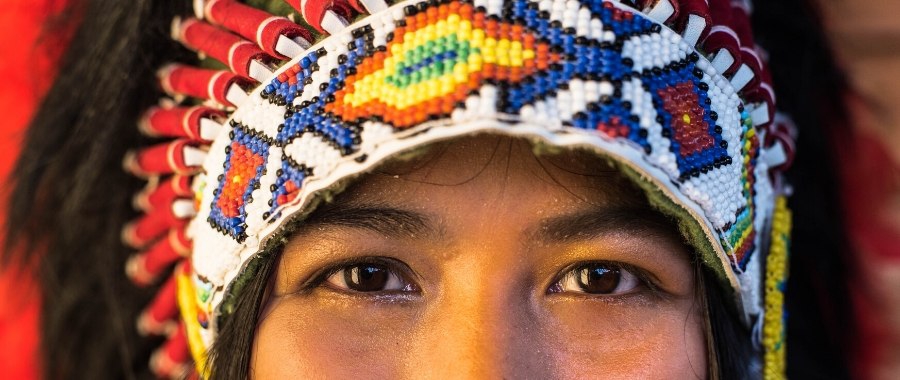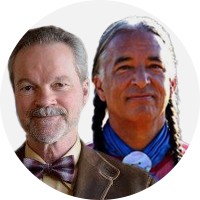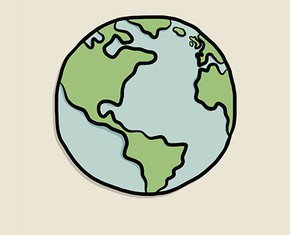The views expressed in our content reflect individual perspectives and do not represent the authoritative views of the Baha'i Faith.
Have popular and romantic “pan-Indigenous” ideas influenced the traditional teachings of Indigenous messengers of God, and thereby altered some of the original native spiritual traditions?
In this series of essays on Gluskap – the Mi’kmaq holy figure – Lakota artist, author and performer Kevin Locke and religious scholar Chris Buck ponder that possibility and what we can potentially do about it.
Q: Kevin, can you help me understand what appears to be a tendency to ascribe all modern Mi’kmaq Indigenous beliefs to Gluskap’s ancient teachings?
For instance, I just accessed this publication by the University of New Brunswick’s Mi’kmaq-Wolastoqey Centre, as part of the “Wabanaki Collection”: “Wolastoqiyik and Mi’kmaq Studies: Elementary Level.”
Here are some teachings that are ascribed to Gluskap (here spelled “Koluskap”):
“All My Relations”
In the beginning, Creator made the stars, moon, sun, clouds, and thunder beings. Creator also made Mother Earth and upon Mother Earth Creator placed many gifts such as trees, streams, rivers, oceans, mountains, plants, and stones. Creator then made the four-leggeds such the moose, deer, bear, wolf, fox, and all of the other animals found in the forest. Creator made the winged-people such as the eagle, crow, robin, butterflies and the sparrow.
Creator made the water-people such as the salmon, trout, whale, and dolphins. Creator placed the water-people in rivers, streams, lakes and oceans. Creator made the plant people such as sweetgrass, sage, red willow tobacco, cedar, and many more.
Creator then decided to make the Wabanaki people. The word “Wabanaki” means “people of the dawn”. The Wabanaki people include the Wolastoqewiyik, Mi’kmaq, Penobscot, and Passamaquoddy. The Wabanakis wondered why they were placed on Mother Earth and so our Creator decided to send Koluskap [Gluskap] to teach them. Koluskap gathered the Wabanaki people and held a council. Everyone was asked to sit in a circle and Koluskap began the council by lighting a Sacred Fire and smoking a Sacred Pipe. Koluskap then began his teachings:
“Brothers and sisters, our Creator has sent me to teach you the sacred ways of the red road. If you follow this road, it will take you to the Sacred Lodge of our Creator. First, you will always honor our Creator and give thanks for the many gifts that our Creator has placed on Mother Earth. You will also honor your Elders because they have wisdom and knowledge that everyone will need. Their wisdom will guide you and help you to remain on the red road.
You will honor creation by saying “All My Relations”. This will remind you that you are related to the four-leggeds, winged people, water people, tree people, plant people and all of creation. Because they are your relations, you will respect them, honor them, value them and learn from them. They have lessons to pass on to you. Your mind must be open to their messages. Your heart must be filled with love and compassion for all of creation.
When you look up to the sky during the day, you will see Father Sun. In the evening, you will see Grandmother Moon as well as the stars who are your ancestors. Look to the sky each day and each evening and say “All My Relations”. Look to the mountains, rivers, streams, brooks, and say “All My Relations”. Look to the forest and say “All My Relations” because it is the home of the four-leggeds, winged people and plant people.
My brothers and sisters, thank you for listening. Remember these teachings and pass them on to your children and grandchildren. Instruct them to pass these teachings on to their children and grand-children as well. These teachings will remain with you forever. I must leave for now but I will be back to share more teachings with you. We will have another council when I return from the Sacred Lodge. All My Relations!”
Koluskap ended the council by asking everyone in the circle to offer red willow tobacco to the Sacred Fire. This offering was made to give thanks for Koluskap’s teachings. The smoke from the Sacred Fire also sends a message to our Creator that the teachings will always guide them in their actions. – “Wolastoqiyik and Mi’kmaq Studies: Elementary Level,” p. 37.
Do you see the problem that I have with this text? Repeated invocations of the phrase, “All My Relations” (as well as the reference to “Mother Earth”) make it sound like all this may have been borrowed from Lakota sacred traditions ascribed to White Buffalo Calf Woman. Do you agree?
A: Yes, Chris, as far as I know, the Lakota/Dakota are the only ones who use the phrase: “mitákuye oyás’iŋ” or “all my relations.” Also the terms “four legged,” “winged,” etc. seem like they are taken directly from the well-known book Black Elk Speaks.
Q: If so, would you like to comment on what appears to be going on here? Are the teachings of White Buffalo Calf Woman being universalized in a kind of “pan-Indigenous” way, such that they are being ascribed to Gluskap, and put in his mouth, as it were, since his original teachings may have been irretrievably lost?
A: That is an interesting question! Anywhere that the language is intact, those who document spiritual traditions would tend to translate phrases directly from the original language.
Several years ago I tutored a Baha’i study class at Eskasoni, Nova Scotia, with about 10 participants. (The Eskasoni folks are Mi’kmaq.) Because English is a distant, second language for them, every few minutes the group would have to take a break to process the information in their mother tongue, which made me think that certainly Gluskap or some divine being bestowed a language rich in spiritual nuances.
Q: Interesting and insightful! So here we are, you and I, advocating for recognition and respect of the Indigenous messengers of God. At the same time, so far, we have tried to be judicious in our selection of primary sources. We have done our best to critically sift the authentic from the inauthentic. Would you agree that it is really an impossible task to do these things with any degree of certainty?
A: Yes, it is daunting. But I am so appreciative that you have taken the lead to begin the process of introducing the spiritual foundations of this land to a broad readership.
Q: So how can we reconcile what appear to be pan-Indigenous teachings seemingly put into the mouth of Gluskap? Of course, we cannot and should not accuse the authors of the above text of essentially plagiarizing Lakota teachings! So help me out here, Kevin, because I’m struggling to understand what’s going on with all this information, and how to put it in perspective.
A: I see it all as part of an awakening process. As we become more fully conscious, erudite individuals will be able to provide clarification, just as we are attempting to do in this series.
Q: It has often been said that popular culture “romanticizes” sacred Indigenous teachings. We ourselves may be vulnerable to such a criticism! We are not, are we? What would you say?
A: Our Indigenous spiritual heritage has been suppressed, persecuted and vilified for so many centuries that it is hard not to perhaps over-compensate on the positive side.
Q: So what’s the takeaway from all this? What is your best advice for Baha’is, and for the public in general, in understanding and responding to these modern presentations of ancient Indigenous sacred teachings?
A: As in all things, we must seek out reliable sources. Fortunately, we have a divine standard in the Baha’i writings, which we can use as a powerful light that we can shine on any matter and discern the true, universal elements therein.
Q: What implications does all this have for the “Baha’i-Indigenous” encounter? Do Baha’i teachings complement and complete Indigenous sacred teachings and further universalize them? In a sense, do the modern Baha’i teachings authenticate, rejuvenate, and update Indigenous sacred teachings? Or am I going too far here?
A: The Baha’i teachings enable us see Indigenous spiritual teachings as part of a progressive enlightenment, or spiritual evolution. All of these God-sent revelators brought information attuned to the exigencies and temperament of the people who they appeared to and taught – as the Universal House of Justice so beautifully and eloquently expressed in its message to the Baha’i Unity Conference on the Navajo Nation in 1972:
Beloved Friends,
Praise be to the Almighty that you have gathered in that beautiful spot in a spirit of love and harmony for the purpose of strengthening the bonds of unity between yourselves and among all men.
The All-Wise Creator of earth and heaven has from the beginning which has no beginning sent to His peoples Divine Messengers to guide them to the Straight Path. These Wise Ones have come to establish the unity of the Kingdom in human hearts. This great evolutionary process of building the organic unity of the human race has entered a new stage with this mighty message of Baha’u’llah. His voice is the voice of the Great Spirit. His love for human kind is the force of the New Age.
He who sends the rain, who causes the sun and the stars to shine, the rivers to flow, the winds to blow and the earth to give forth her bounties has in this Great Day sent to all mankind Baha’u’llah. It is this Great One who has opened the door of divine knowledge to every soul. It is His teachings that will establish world unity and bring about universal peace.
The people of the world are the tools in His hand. They must strive to understand His message and to walk in the path of His divine guidance. Every human being is responsible in this day to seek the truth for himself and thereafter to live according to that wise counsel. The old ones have all longed for this sweet message. Praise God that you have found it.
Now awakened to new wisdom, now guided to the straight path, now illumined with this mighty message, strive you day and night to guide and assist the thirsty ones in all lands to the ever-flowing fountain, the wandering ones to this fortress of certainty, the ignorant ones to this source of knowledge and the seekers to that One for whom their hearts long.
May your consultation reach so high a level of endeavor and purpose that the Great One will open before your faces the doors of the paradise of wisdom and love and cause the light of the Abha Beauty [Baha’u’llah] to shine in your midst.
With loving Baha’i greetings,
The Universal House of Justice, 18 May 1972
















Comments
Sign in or create an account
Continue with Googleor